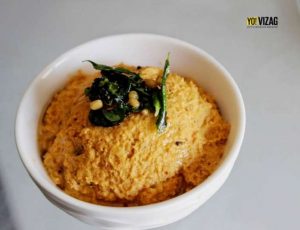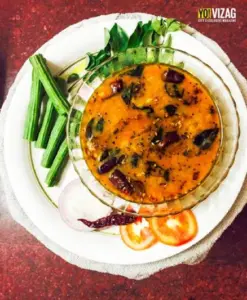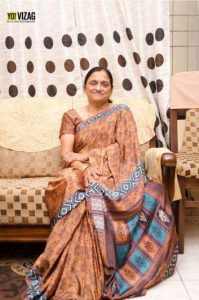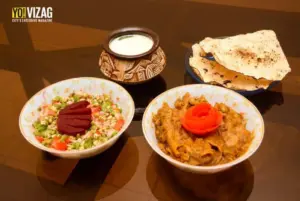Grandmother recipes: A world of warmth. An ocean of learning. And an embodiment of experience. A Grandmother is all that and much more. With fascinating stories to tell, we at Yo! Vizag team met up with four such wonderful women from our Vizag. From Lakshmi Parthasarathy to Dr. Lavanyalatha, and from Sheela Raghani to Kalyani Dhanraj, each of them gets talking not just about the societies that shaped their lives, but also about the city that shaped their destiny. With a common thread of cooking, that ties these pearls of stories together, we bring you a glimpse into their lives, and a peek into their kitchens. Read on and save this Grandmother’s Recipe Book.
Kocherlakota Lakshmi Parthasarathy
In the feature image
We grew up with the times and they do with theirs. We don’t have to worry about them.
Her tryst with Vizag began in 1968, when her husband, who was a Trustee of Visakhapatnam Port decided to retire here. A plot in Kirlampudi was thus purchased and Mrs. Parthasarathy personally supervised the construction of the beautiful stone house at Plot 47 that is one of the few independent houses that still stands today. Perhaps one of the oldest residents of the area, they settled here in 1980. After her husband passed away in 2013, she decided to live in the independent house, enjoying the neighbourhood that transformed right before her eyes. Over the last thirty years, she has played active roles, from being member and President of the Inner Wheel Club to Chairperson of the Ladies Committee of the Waltair Club.
Speaking of her early years, she shares that she was born in Warangal in 1924, was the eldest daughter of a prominent lawyer from old Hyderabad state, and came from a family of six children. Educated at a school run by Americans, she completed her matriculation at Vijayawada after her family left Warangal because of plague in the area. She went on to study at the Lady Hope College after which she was married in 1946 at Hyderabad. In 1950 she left for UK with her husband and on her return to India continued moving from Bombay to Calcutta and Madras in line with his transferable job.
Along with an active social life, Lakshmi Parthasarathy has been an ardent lover of gardening, with her independent house giving her ample opportunity to create a beautiful garden full of exotic plants that she collected from different parts of the country. She enjoyed embroidery too and has created some beautiful wall hangings in crewel work and applique, some of which continue to adorn the walls of her house even today. An excellent cook, her breakfast parties and special varieties of pacchadis were much talked about. Though age has slowed her down, she continues to enjoy Tambola at Waltair Club once a while and catches up with her old friends. A woman who values her independence, this is what she says about the current younger generation: “We grew up with the times and they do with theirs. We don’t have to worry about them.”
Grandmother recipe #1-Toor (kandipappu) Dal chutney

‘This simple pacchadi recipe is not just wonderful comfort food but is very easy to make too.’
Ingredients:
½ cup Toor dal (broken, not powder)
4 pcs Dried Red Chillies
1 tsp Tamarind paste
¼ tsp Jeera
Pinch Turmeric
Salt to Taste
Method:
Lightly fry the dal. Add the chillies and take off the fire. Add rest of ingredients and then grind them together into a coarse paste.
Season with 6- 8 curry leaves, ½ tsp urad dal and ¼ tsp mustard seeds.
Dr. Lavanyalatha Agarwal

I was always asked to concentrate on my studies and not worry about the rest.
Unlike many women of her time, Dr. Lavanyalatha Agarwal was encouraged to be independent and have a career from the get-go. Her mother never thought it a priority that her daughter learnt how to cook and she was never required to help out with the housework. “I was always asked to concentrate on my studies and not worry about the rest.” Being a doctor was a profession she had no choice but to go into. Her father would always say, “Munniko doctor banayenge.” (Let’s make Munni a doctor). Coming from a family of engineers and doctors, it became a matter of prestige for her to get a medical seat. But growing up, she loved reading Hindi literature and believes she would have made a good teacher of the language.
She concentrated on her practice after graduating and only turned to cooking after marriage. She knew how to make parathas and rotis but the process of cooking dal chawal and curries eluded her. Shifting to Vizag from Delhi after marriage, Lavanyalatha taught herself cooking on a trial and error basis. Back then, she drove a Royal Enfield Fantabulous scooter and believes she was one of the first women in Vizag to do so. When asked about the change she’s seen in Vizag through the years she says, “I had to depend on my siblings in Delhi to get anything I needed. But now Vizag has changed, we find everything we need here itself. My only complaint is that it’s too crowded now.”
Grandmother recipe #2- Phirni

“While I like to cook various dishes like Caramel Custard, mawa stuffed Gujiya and janthikalu; Phirni is the dish everyone in my family truly enjoys. We prefer to make this creamy phirni over the regular old kheer.”
Ingredients:
Milk – 1 ltr
Rice – 60 gms
Sugar – 100 gms
Elaichi powder (cardamom) – to taste
Kesar & chopped pistachios – for garnish
Method:
Soak the rice overnight and let it dry the next day. Grind the rice till it’s soft and sieve it. Keep the ground rice aside. Heat the milk and let it reach to a boil. When it does, pour in the ground rice in small quantities and keep stirring so as not to form lumps. When the rice is cooked and the mixture thickens, add in the sugar and stir. Add in the elaichi powder and mix in well. Garnish with kesar and chopped pistachios. Phirni is best served chilled.
Kalyani Dhanraj

Sundays would find us waking up at four in the morning to cook breakfast and make coffee in a jiffy before heading out to the Roman Catholic church in town.
Learning to cook from her mother as a young Tamilian in Vizianagaram, Kalyani Dhanraj thought herself fortunate to be endowed with Kai Manam (fragrance of hand). Enjoying the idyllic childhood of a woman growing up in a small town, surrounded by farm animals, Kalyani and her sisters would help their mother with the cooking at home on a pre-planned schedule. “Sundays would find us waking up at four in the morning to cook breakfast and make coffee in a jiffy before heading out to the Roman Catholic church in town”, she says.
Her formal education stopped at class 10 because that was all her father allowed. Marriage brought her to Vizag when she was nineteen. Her husband would help her with the cooking as there were six little mouths to feed. She would have a tough time when he had to work night shifts and couldn’t lend her a hand. Having lived through the times that saw the status of women change, she believes that the notion people once had that it’s a woman’s job to look after the housework is silly.
Other than cooking, Kalyani has an affinity for music and nature. She loved listening to Tamil classics on the gramophone they owned while growing up. “I’d love to sing, but I have a nasal voice,” she laughs. “I taught my daughter Ramani how to play the veena but she plays pianos and guitars now.” The plant lover that she is, Kalyani’s house is filled with various kinds of plants. “I would water them myself if my knees would permit, but I make sure they’re well taken care of,” she says.
Grandmother recipe #3- Murungakka Sambar (Drumstick Sambar)

“I learnt this recipe from my mother in the 1950s. They say ‘the proof of the pudding is in the eating’. In case of the Sambar, it’s all in the sambar podi. When I was young I used to watch the domestic help grinding the podi at home. But now the grinder does that job.”
Ingredients for the Sambar podi (Powder)
Coriander seeds – 500 gms
Chana dal – 250 gms
Toor dal – 250 gms
Urad dal – 100 gms
Fenugreek seeds – 50 gm
Asafoetida – 1 Tsp
Dried red chilli – 200 gm
Pepper corns – 10-12
Rice – just a handful
Curry leaves – 5 sprigs
Method:
Dry roast each item separately and grind to a coarse powder after it cools down.
Ingredients for the Sambar:
Toor dal – 250 gms (1 cup)
Tomatoes – 4 (medium sized)
Potatoes – 2 (medium sized)
Onions – 4
Sambar onions (Shallots) – 6
Long Murungakka (drumsticks) – 2
Garlic – 3 pods (optional)
Other Ingredients
Oil – 2 tbsp
Fenugreek seeds – ½ tsp
Mustard seeds – ½ tsp
Red chillies – 2 (for seasoning)
Curry leaves – 2 sprigs
Coriander leaves – 4 sprigs
Asafoetida – ¼ tsp
Sambar podi – 3 tbsp
Cumin seeds – 1 tsp
Turmeric powder – 1 tsp
Tamarind – small lemon sized ( Soak for 20 mins)
Salt – 1 tbsp
Jaggery – ½ tsp (optional)
Method:
Peel and chop the potatoes into bite-size pieces. Cut the tomatoes and onions. Pressure cook the dal, tomatoes, potatoes, onions and garlic with cumin seeds and turmeric powder in 3 cups of water for 10 minutes/5 whistles. Chop the drumsticks into 3 inches long pieces and put them in a pan with the cooked sambar mixture. Cover with a lid for 10-15 minutes on medium flame until the drumsticks are soft and tender. Squeeze out the tamarind and strain the juice. Add tamarind juice, salt and jaggery to the sambar. Reduce the flame and add asafoetida and sambar powder. Let it simmer for 10 minutes. Heat oil in a small pan, add the mustard, cumin, fenugreek seeds, red chillies and curry leaves. Once it splutters, and you get the aroma, add the seasoning to the sambar.
Sheela Prakash Raghani

Maybe my parents would’ve let me study further than tenth class if I’d thrown a tantrum.
Hailing from Lucknow and married at the age of 17, Sheela Raghani’s connection with Visakhapatnam began way back in 1969, when she came here as a young bride. At that time, she would feel like a city girl in a small town, with the most basic of luxuries- like a plate of pani puri, unavailable in the region. But over the years with the change she’s seen first-hand, Sheela feels that it’s not just the city, but she has literally grown with Vizag. Not only did she learn to speak Telugu, but she also acclimatised herself with the orthodox ways of those times. With her husband working in the textile business, her early years spent at Chengalaraopeta in a joint family were memorable.
Talking of her early years, she shares that she grew up as the pampered eldest child of the family, and took an interest both in academics and arts. While it was the latter that led her to various creative endeavours, cooking and housework were considered the most important lessons. Just like most girls in her Sindhi community back then, it was something she accepted, but looking back she says, “Maybe my parents would’ve let me study further than tenth class if I’d thrown a tantrum”. Nevertheless, she likes the fact that women these days are independent.
Getting married changed things in many ways for Sheela. So while, she had servants to do her bidding back home, at her in-laws, she was required to cook along with her sisters-in-law and mother-in-law. Luckily for her, here the men helped out with the cooking too. There were days they would take care of making the evening snacks so that the women could relax. Because of this, feeding the huge joint family they lived in never seemed like an impossible task. While she can cook up a storm of different varieties of curries and parathas, festive food is really her forte. “But the recipes are so extensive, no one makes them anymore. Also, the elders don’t eat them due to health issues and the kids are diet-conscious,” she laughs.
Grandmother recipe #4-Seyal Maani (Rotis in coriander masala)

“This recipe has been handed down through generations of Sindhis across the world. It’s a delicious way of using leftover rotis. For me, it brings back sweet memories of winters from my childhood. Hope you enjoy this dish as much as I do.”
Ingredients:
Rotis – 4, quartered
Refined oil – 4 tbsp
Salt to taste
Coriander (dhania) powder – 1 tbsp
Turmeric (haldi) powder – ½ tsp
Cumin (jeera) powder – ½ tsp
Tomato paste – 1 cup
To be ground for the green masala paste:
Green coriander (kothmir) – 2 cups, chopped
Sorrel leaves (chukkakora/chuka) – 8-10
Green chillies – 3-4
Garlic – 8-10 cloves
Ginger – quarter piece
Onion – 1, medium sized
Method:
Heat 3 tbsp oil and add the green masala paste. Stir-fry on a medium flame for 5-7 minutes until the raw smell of onion disappears. Now add the tomato paste, salt and dry spices. Stir for 3-4 minutes then cover and cook till tomatoes are softened. Now add 2 cups of water and bring to a boil. Then put in the rotis (maanis). Cover and cook on a low flame for 5-7 minutes. Serve hot with a bowl of fresh yoghurt, some sprout salad and sindhi papads.










Discussion about this post